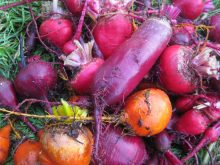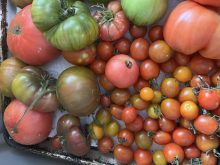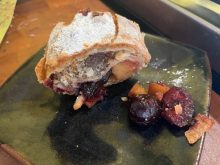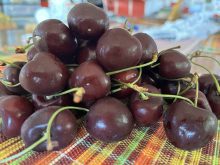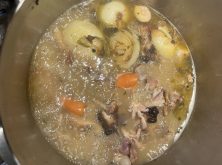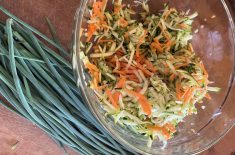Is the melody of your life without some of the right notes or is there a barrier standing between your health and happiness? There’s an old saying that a person with his health has a thousand dreams but a person without health wants only to get well. More and more gardeners of all ages are taking greater responsibility for their personal health, food uncertainty and shortages.
A reverse situation has started. Many annual flower beds have become smaller and are giving way to space for homegrown vegetables, herbs and fruits. Since 2020 more than two million Canadians have planted a garden for the first time. It’s no longer just, maybe I’ll have a garden. My very survival may depend upon it someday. This isn’t meant to frighten anyone, but that old Boys Scouts motto still holds true more than ever today — Be Prepared.
You may have heard expressions or statements using the words “plum dandy.” That’s a plum dandy idea is one example. Hope for Humanity is a plum dandy, hardy shrub rose bush with attractive dark red flowers introduced by Agriculture Canada in 1996. Simply explained, the two words plum dandy mean “very good and worth having.”
Read Also

Gentle treatments for pain in the neck
Heading toward year-end, people unknowingly tense up against the cold and busyness, causing neck pain that can often be treated with appropriate support and gentle mobility, athletic therapist Kathlyn Hossack says.
Here’s more plum dandy news. Let me ask — do you ever eat prunes (dehydrated plums) and/or drink prune juice in the morning to activate your bowels and get things moving? If doing so for the first time, phase into prunes and prune juice gradually to determine the amount that works right for your system. Here’s still more news that’s unknown to a lot of folks. Prunes and most kinds of fresh and canned plums could also be good for your bones and your heart, and they might even reduce the risk of cancer.
Well as I live and breathe, I’m ready to reveal what’s next in my rollout of words in this issue of Grainews. Folks clean across the country bought thousands of amaryllis bulbs during our recent holiday season in December but a lot of them don’t know how to treat the bulbs and get them to rebloom again. I’ll walk readers through the process to achieve reblooming results and then close out the show with some info about pollinating plum trees.
I’m still plum crazy over this same old durable well-weathered hat that I’ve worn, washed, starched and waved to my readers countless times now throughout many years. You’re as welcome as the sun which now extends daylight somewhat longer and stronger with a hint of spring to come according to the calendar a couple months from now.
Reblooming an amaryllis
The three tricks to reblooming an amaryllis bulb are a period of dormancy, darkness and a cool storage area. Once the flowers have finished blooming, cut them off and remove the stalk. You don’t want seed pods to develop and absorb energy from the bulb. However, do allow strap-like leaves to continue growing to become deep green and healthy when the plant is placed in a bright sunny window. Water as required and feed monthly with a balanced half-strength plant food for flowers.
Once weather permits and frost threats are done, place each amaryllis outside in a sunny location. Some filtered light during the hottest part of the afternoon is ideal. If you want blooms for next Christmas/New Year season, withhold all water and plant food starting at the end of August or later and allow entire foliage to die back naturally. Prior to fall frost, cut off all dried parts on the top to within an inch or two above the neck of the bulb. Lay each pot containing a bulb on its side and place in a completely frost-free, cool dark spot that is 10 C (50 F) or cooler. Check each bulb periodically. Eventually hints of emerging growth will appear about the end of October or early November. Then, bring the potted bulb into bright light and water well, allowing the potting growth medium to become dry between each watering. Flowers and leaves will appear in time for the festive season.
Forcing bulbs indoors means manipulating or altering the flowering time frame and getting bulbs to bloom when you want. You can stagger-plant most any bulbs, including amaryllis, to extend or alter the growing and flowering seasons.

To recap, with good care, amaryllis bulbs will develop and continue to bloom for many seasons. For hopes of really big leaves and eventual giant flowers, try this. Bury the pot containing the amaryllis bulb up to its rim into outdoor garden soil in summer. In fall before frost, remove the pot from garden soil and clean it. Bring the pot inside and allow the foliage to completely dry indoors in a cool spot without any water for six weeks or so, then cut off all dried parts, repot the bulb in fresh potting mix and place it near a bright warm window. New shoots will appear within days followed by amaryllis flowers.
Plum tree outside
A fellow gardener said to me, “Better to try something and fail, than to try nothing and succeed.” One way we get ahead and remain there is to use our head whether we are gardeners, farmers or whatever skills we possess.
I received this question: “My plum tree has flowered each spring for several years now, but never produces any fruit. Does it need pruning or what?”
My response: A single healthy hybrid plum tree growing all alone needs a correct mate in a type of kinship to produce offspring, in this case plums. A lonesome, non-producing mature plum tree needs companionship badly, sort of the right kind of buddy you might say. To anyone thinking of planting a hybrid plum tree, it is important to understand how their pollination works. Hybrid plum trees are self-sterile and cannot produce fruit alone. Moreover, they are not good pollinators for one another. Even if you plant two different varieties next to each other, you are unlikely to harvest any fruit at all. So, what’s required? Hybrid plum trees need a wild plum tree to pollinate them — either the Canada plum (Prunus nigra), which is considered the best pollinator, or the American plum (Prunus americana) which also works well. If you intend to plant plum trees, you must also plant at least one of these nearby, unless of course there already happens to be one nearby such as in a neighbour’s yard. One wild plum tree is enough to pollinate up to five or so grafted plum trees.
A drawback of plum trees is they tend to flower early, making them sensitive or vulnerable to freezing from early and late spring frosts. Chilled or frozen blossoms mean no fruit. The same thing applies to apricot trees, which are also early bloomers. Any area for growing plums with a kind of delayed start tendency, or a south side shelter belt of evergreens or bluff of trees, will help to mitigate loss. Also, applying a thick circular layer of mulch or compost underneath the base of each tree or bags of dried leaves once the ground remains frozen is ideal. Or, when lots of snow has fallen, this makes a difference too. Such insulation maintains a colder soil environment for a longer period around the trunk base of each tree and delays the start of flowering.
In closing, a self-fertile tree can produce fruit even when it is alone. On the other hand, if a self-sterile tree is alone without a pollinator, it will produce flowers, but the flowers will not turn into fruit. It is also worth noting that even when a tree is designated self-fertile, it will still give greater yields with a pollinator nearby. In general, the more genetic diversity around, the more fruit your trees will produce.




